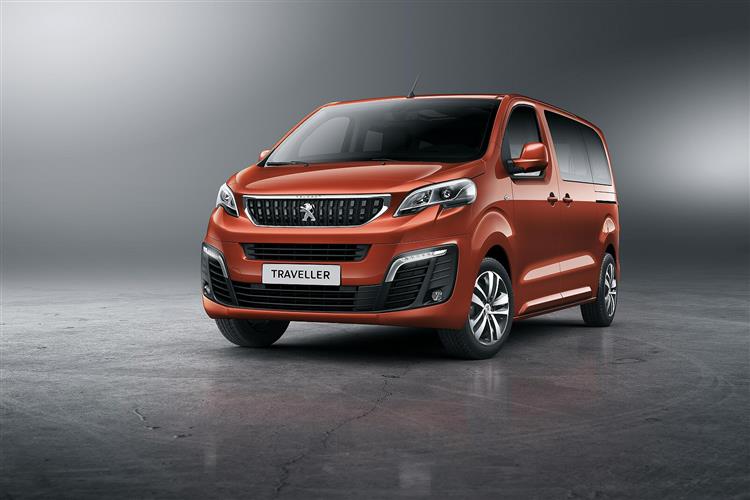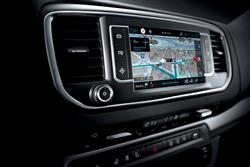TRAVELLING MERCIES (some text hidden) --NONE--
By Jonathan Crouch
Introductionword count: 155
Back in 2016, Peugeot aimed to set a fresh benchmark in the super-large MPV segment with this Traveller model, which in its first four years of production was only offered in the diesel form we focus on here. Though based on the brand's medium-sized Expert van, it also shared its EMP2 platform with some of the French maker's more conventional car models and that, along with sophisticated suspension, meant a standard of ride difficult to better in the segment. This model's running cost figures also set a fresh class standard and there was a wider variety of seating permutations than most rivals of this period could offer. Indeed, depending on the version you choose, your Traveller could take as many as nine people. On paper at least, larger families seeking a relaxed, connected and very spacious ownership experience from a large MPV from the 2016-2022 period could well find a lot to interest them here.
Modelsword count: 14
5dr SUV (1.6,1.5 BlueHDi diesel / 2.0 BlueHDi diesel / 50kWh full-Electric [Active,Business,Business VIP,Allure]
Historyword count: 529
When it comes to really spacious seven-seat People Carriers, Peugeot used to make large ones - models like the 807 and the 5008. By the middle of this century's second decade, the brand wasn't bothering with that any more. By then, Peugeot had decided to offer an MPV that wasn't merely large but took customers to the next level beyond that. And so arrived in 2016 the Peugeot Traveller. In many ways, you can see the reasoning here. The kind of sizeable People Carrier this French brand previously made wasn't much use if, when completely filled up with people, those passengers wanted to bring baggage with them. With all seven seats filled up, the boot in the company's old 807 and 5008 models was supermini-sized and it was the same with large car-based People Movers of the 2016-era like Ford's Galaxy and Volkswagen's Sharan. To solve that issue Peugeot realised, it was necessary for the MPV in question to be designed from a more spacious starting point. Which meant basing it on a van. Peugeot knew how to do this. By 2016, its LCV-based Partner Tepee model had long been a strong seller for the company in the compact MPV segment and for most of the decade between 2006 and 2016, business buyers were offered a passenger-carrying 'Tepee' version of the Expert van. This Traveller model was also based on an Expert commercial vehicle, but in this case, the much more sophisticated third generation version which incorporated big parts of the EMP2 platform that Peugeot was using on its larger car models. These were underpinnings sophisticated enough to allow the brand to create in this Traveller MPV something more than just another industrial People Carrier. Here, they decided, was a vehicle that could bring something new to the super-large MPV segment frequented by well-heeled families with an almost permanent parking bay at the maternity unit. People who before 2016 had been buying seven and eight-seater models like Volkswagen's Caravelle and the Mercedes V-Class. In taking on these two class leaders, this Peugeot arrived with some significant advantages to counter any perceived lack of brand credibility. For one thing, it cost thousands less to buy, yet offered a similar standard of cabin quality. Plus it was far lighter, which made it more efficient to run and more agile to drive. There was also a wider range of possible seating permutations in a Traveller - you could carry up to nine people if you ticked all the right boxes. From a Peugeot dealer's point of view, the only fly in the ointment lay with the fact that the Traveller shared its design - and therefore all these virtues - with two other direct rivals, Citroen's SpaceTourer and Toyota's Proace Verso. And later also with the Vauxhall Vivaro Life too. Peugeot though, reckoned it had packaged up this proposition in a more appealing way. It all sounded quite promising, but the Traveller, like its clones, never really sold in any great numbers and combustion diesel versions were phased out in 2022. The full-electric E-Traveller model though (introduced in 2020) continued on. Here, we look at the diesel-engined Traveller as a used buy.
What You Getword count: 657
Large, van-based MPVs certainly aren't what they used to be. Take this Peugeot Traveller for example. Though clearly commercially-derived, it's got a bit of style to it, with compact overhangs and a high window line giving a bit of purpose to the boxy shape. The 1.9m height of the long flat roof is important - it means this model can fit under normal carpark height restrictions. And the length is critical too. Don't automatically assume that a super-large MPV like this has to be super-long from bonnet to rear bumper. One of the early body style options with this model was a 4.6m-long 'Compact' body shape that actually measured in at around 250mm shorter than car-derived MPVs like Ford's Galaxy or Volkswagen's Sharan. But that variant was quickly discontinued because most Traveller buyers wanted the extra interior room of the 4.95m-long 'Standard' version. There was also a 5.3m-long 'Long' option for those who really wanted to super-size things. At the rear of this MPV, the vertically stacked lights flank a tailgate rather than the twin side-hinged rear doors you'd get on an Expert van. The luggage space you get here with all three rows of seats in place obviously varies depending on the body style you've chosen. With the mid-range 'Standard' body shape, there's 627mm of length from the back of the third seating row to the tailgate, which means you get 640-litres of cargo space up to the level of the load bay cover - or as much as 900-litres if you were to load to the roof. A lot of the time of course, you'll be using this Peugeot with only five seats in place. If on the 'Standard' body shape model, you fold the third row backrest onto the seat base, you'd increase loading capacity to 1,100-litres - or 1,950-litres loading up to roof height. Finally, let's cover the capacity you'd get when you only need the front two seats. In the 'Standard' body shape model with second and third row backrests folded onto their bases, you'd have 2,000-litres of space up to parcel shelf level and 3,000-litres up to roof height. If you were to entirely take the second and third row seating out, those figures would each rise by 1,200-litres. Enough on luggage space: what's this Peugeot like for people? Let's start by considering things up-front, access via a wide-opening driver's door and a step up behind the wheel. Most Travellers you'll find will be 'Business'-trimmed variants, a spec level which from new came with the no-cost option of the dual front passenger bench that would normally be fitted in an Expert van. The fascia's focal point is found with a centrally-situated 7-inch 'Peugeot Connect' colour touchscreen, which back in 2016 was the most sophisticated we'd come across in any of the brand's models. It includes a 'Mirror Screen' feature, so you can duplicate your smartphone's display onto the monitor via either the 'Apple CarPlay' or the 'MirrorLink' 'Android Auto' systems. In the second row, where you get ample knee, shoulder and head room, there's a three-person rear bench that'll have a 60:40 split in it, provided you've got a mainstream version rather than one of the top VIP-trimmed models. On plusher variants, the seats are mounted on rails so can slide backwards and forwards - though not individually: the middle seat will be joined to one of the outer ones. In the third row of this Traveller, the outer passenger-side seat lifts and tilts forward to aid access, something further aided by the provision of higher roofline than you'd find in something like a Sharan or a Galaxy. Once you're in the third row, you'll be reminded just why medium-sized vans make such a great starting point for a properly large family-sized MPV. Instead of being crammed in cattle-class, as you would be in even the largest car-based People Carriers, there's more than enough space here for arms, legs and heads.
To see the full road test text contact us on 0330 0020 227
Pictures (high res disabled)

.jpg)
|
.jpg)
|
.jpg)
| |||
.jpg)
|
.jpg)
|
.jpg)
| |||

|
Scoring (subset of scores)
Category: MPV People Carriers
| Performance | |
| Handling | |
| Comfort | |
| Space | |
| Styling, Build, Value, Equipment, Depreciation, Handling, Insurance and Total scores are available with our full data feed. | |



